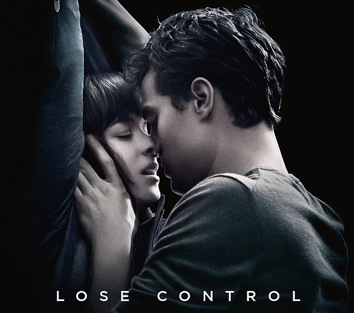Written by Katherine Murray.
“What even is porn, really?” That’s the question I eventually asked myself when I broke my self-imposed boycott on Fifty Shades of Grey. The trailer for the second movie – which looks almost exactly as creepy and aggravating as the first movie, but with more masks – landed last week and, like it or not, a story that began life as an X-rated Twilight fan fiction is now in mainstream theatres, presenting itself as art.
Part of me wants to say it’s foolish to try to talk about Fifty Shades of Grey as if it’s anything but porn. When the novel series first became popular, a lot of the commentary about it involved people who weren’t familiar with fan fiction responding to it as a novelty – with either amusement, curiosity, or some combination of the two. It’s easy to make fun of X-rated fanfic – what turns people on is so idiosyncratic that it almost always seems ridiculous to someone else – but, over the years, I’ve learned to take a live-and-let-live attitude. People can’t control what turns them on, and it’s unkind to argue about it with them. None of us would come off looking awesome if our sexual fantasies were projected on a cinema screen. Even if your fantasy is about men’s domination of women through non-consensual sex and domestic violence – which, let’s be clear, is the central fantasy in Fifty Shades of Grey, even though it’s wrongly presented as BDSM – as long as no one’s getting attacked in real life, your fantasies are your own business and no one should make fun of you or criticize you for them. The world is a terrible place, and it sometimes conditions us to be aroused by things we might not have otherwise chosen. You may as well enjoy it if you can.
When I look at Fifty Shades of Grey as porn, I don’t especially like it, but I don’t judge other people for liking it, either. And that’s where the discussion would stop, if it were playing in an adult movie theatre, instead of a multiplex. The Fifty Shades movies are marketed as R-rated, mainstream dramas – to a certain extent, they’re also marketed as romance, which is a completely different problem, since there’s nothing romantic about this relationship. While it’s very likely the series was marketed this way in order to maximize profits and make the most money possible, it also moves them into a space where they could be considered art.
Most people (rightly) expect more from art than they do from porn; we expect art to offer a perspective or point of view, to have a message, to be more than a spectacle to press the pleasure centers of our brains. Watching Sam Taylor-Johnson’s film adaptation of the first novel (which I have not read), I can see that she tried to make art. The main character goes on a journey from beginning to end – it’s not a very happy journey, but it’s one where she finds the courage to say no to the older, charismatic man who’s slowly taken control of her life – and there’s a sense of finality and completeness. The acting and camera work also convey layers of complexity that the bare bones of the story do not. At the same time, most of it still feels like spectacle. And, while I don’t think it’s wrong to say that Fifty Shades of Grey fares pretty poorly as art, I do think it’s wrong to single it out, as if our cinemas aren’t full of spectacle already.
I get why people hate Fifty Shades of Grey more than they hate other spectacle films, and, in my heart, I kind of hate it, too. Its raison d’être is to let its audience take pleasure in watching a man mistreat a woman and it largely fails to demonstrate a critical understanding of what that means. For a film presenting itself as art, that makes it look pretty misogynist. For a film presenting itself as a beginner’s guide to BDSM, that makes it look ignorant (not even considering the part where the script’s understanding of the physical mechanics of BDSM rates something like -5). For a story that suddenly made fanfic a part of mainstream culture, I think everyone except for E. L. James would have picked a different flagship.
At the same time, the Saw franchise is on movie number eight now, the last Mission Impossible I saw was just about Tom Cruise putting suction cups on a building, I’ve lost count of how many superhero movies only exist to blow things up, and everyone fawned over the American remake of The Girl with the Dragon Tattoo in which, I contend to this day, we were supposed to enjoy watching torture and rape. It seems like there’s a special kind of shame reserved for spectacles that are explicitly intended to turn someone on – and there’s a special kind of misogyny reserved for them too, because we live in an amazing culture – but Fifty Shades of Grey is not so different from other mainstream spectacles designed for enjoyment.
As I watched Fifty Shades of Grey, and tried to figure out what I thought about it, and whether or not it was fair to criticize something as art when its original purpose was porn, I also started to wonder whether or not it was fair to criticize The Avengers as art, or Suicide Squad, or the new Star Trek movies where everyone runs and their ships keep exploding. Even though critics try to ask themselves if a movie succeeds on its own terms – that is, if it’s a good example of what it’s trying to be, usually according to the standards of the film’s genre, regardless of whether what it’s trying to be is desirable – it isn’t always as simple as saying, “Hot Tub Time Machine delivered what it promised, so it’s an amazing movie.” It’s also not as simple as saying, “We deserve more from our culture than Fast and Furious: Furiously Fast Fast Furious 16.” Life is a balance between reflection and indulgence, and I wouldn’t want to eliminate either.
I think the answer might be that there’s room for both types of response to any kind of film – no matter what the main intention was. The story you hear is always the product of an interaction between the storyteller’s mind and yours – it’s never completely the same for two people and, what one person is happy to enjoy as spectacle might be the same thing someone else spends hours analyzing and picking apart. Neither person’s reaction is wrong – it just reflects two different ways of engaging. (Ask me some time about how much I hated Mad Max: Fury Road or how much I’m willing to hand wave every single thing in The 100).
So, what even is porn, really? It’s a class of film intended to be spectacle that we could all still criticize as art. I didn’t particularly enjoy the spectacle in Fifty Shades of Grey, and I didn’t rate it very highly as art. But enjoying the spectacle, in and of itself, doesn’t make you a terrible person any more than enjoying slasher movies or an endless stream of street racing films does. The popularity of Fifty Shades of Grey doesn’t make mimicking the actions of its characters any more acceptable than blowing up half of New York or going on a crime spree, either, but, if you want to let it push the pleasure centers of your brain, more power to you.
Katherine Murray is a Toronto-based writer who yells about movies, TV and video games on her blog.










